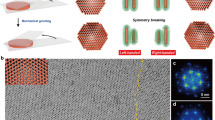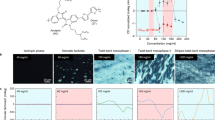Abstract
A dominant theme within the research on two-dimensional chirality is the sergeant–soldiers principle, wherein a small fraction of chiral molecules (sergeants) is used to skew the handedness of achiral molecules (soldiers) to generate a homochiral surface. Here, we have combined the sergeant–soldiers principle with temperature-dependent molecular self-assembly to unravel a peculiar chiral amplification mechanism at the solution–solid interface in which, depending on the concentration of a sergeant–soldiers solution, the majority handedness of the system can either be amplified or entirely reversed after an annealing step, furnishing a homochiral surface. Two discrete pathways that affect different stages of two-dimensional crystal growth are invoked for rationalizing this phenomenon and we present a set of experiments where the access to each pathway can be precisely controlled. These results demonstrate that a detailed understanding of subtle intermolecular and interfacial interactions can be used to induce drastic changes in the handedness of a supramolecular network.
This is a preview of subscription content, access via your institution
Access options
Subscribe to this journal
Receive 12 print issues and online access
$259.00 per year
only $21.58 per issue
Buy this article
- Purchase on Springer Link
- Instant access to full article PDF
Prices may be subject to local taxes which are calculated during checkout





Similar content being viewed by others
References
Wagnière, G. H. On Chirality and the Universal Asymmetry: Reflections on Image and Mirror Image (Wiley-VCH, 2007).
Palmans, A. R. A. & Meijer, E. W. Amplification of chirality in dynamic supramolecular aggregates. Angew. Chem. Int. Ed. 46, 8948–8968 (2007).
Green, M. M. et al. A helical polymer with a cooperative response to chiral information. Science 268, 1860–1866 (1995).
Raval, R. Chiral expression from molecular assemblies at metal surfaces: insights from surface science techniques. Chem. Soc. Rev. 38, 707–721 (2009).
Ernst, K.-H. Molecular chirality in surface science. Surf. Sci. 613, 1–5 (2013).
Elemans, J. A. A. W., De Cat, I., Xu, H. & De Feyter, S. Two-dimensional chirality at liquid–solid interfaces. Chem. Soc. Rev. 38, 722–736 (2009).
Parschau, M., Romer, S. & Ernst, K.-H. Induction of homochirality in achiral enantiomorphous monolayers. J. Am. Chem. Soc. 126, 15398–15399 (2004).
Haq, S., Liu, N., Humblot, V., Jansen, A. P. J. & Raval, R. Drastic symmetry breaking in supramolecular organization of enantiomerically unbalanced monolayers at surfaces. Nature Chem. 1, 409–414 (2009).
Masini, F. et al. Chiral induction by seeding surface assemblies of chiral switches. J. Am. Chem. Soc. 133, 13910–13913 (2011).
Fasel, R., Parschau, M. & Ernst, K.-H. Amplification of chirality in two-dimensional enantiomorphous lattices. Nature 439, 449–452 (2006).
Berg, A. M. & Patrick, D. L. Preparation of chiral surfaces from achiral molecules by controlled symmetry breaking. Angew. Chem. Int. Ed. 44, 1821–1823 (2005).
Destoop, I. et al. Solvent-induced homochirality in surface-confined low-density nanoporous molecular networks. J. Am. Chem. Soc. 134, 19568–19571 (2012).
Chen, T., Li, S.-Y., Wang, D., Yao, M. & Wan, L.-J. Remote chiral communication in coadsorber-induced enantioselective 2D supramolecular assembly at a liquid/solid interface. Angew. Chem. Int. Ed. 54, 4309–4314 (2015).
Nuermaimaiti, A. et al. Chiral induction with chiral conformational switches in the limit of low ‘sergeants to soldiers’ ratio. ACS Nano 8, 8074–8081 (2014).
Sawa, Y. et al. Shape selection of twist-nematic-elastomer ribbons. Proc. Natl Acad. Sci. USA 108, 6364–6368 (2011).
Sakurai, S.-i., Okoshi, K., Kumaki, J. & Yashima, E. Two-dimensional surface chirality control by solvent-induced helicity inversion of a helical polyacetylene on graphite. J. Am. Chem. Soc. 128, 5650–5651 (2006).
Kumar, M. et al. A dynamic supramolecular polymer with stimuli-responsive handedness for in situ probing of enzymatic ATP hydrolysis. Nature Commun. 5, 5793 (2014).
Korevaar, P. A. et al. Pathway complexity in supramolecular polymerization. Nature 481, 492–496 (2012).
Tahara, K., Lei, S., Adisoejoso, J., De Feyter, S. & Tobe, Y. Supramolecular surface-confined architectures created by self-assembly of triangular phenylene-ethynylene macrocycles via van der Waals interaction. Chem. Commun. 46, 8507–8525 (2010).
Tahara, K. et al. Control and induction of surface-confined homochiral porous molecular networks. Nature Chem. 3, 714–719 (2011).
Ghijsens, E. et al. Towards enantioselective adsorption in surface-confined nanoporous systems. Chem. Commun. 51, 4766–4769 (2015).
Blunt, M. O. et al. Temperature-induced structural phase transitions in a two-dimensional self-assembled network. J. Am. Chem. Soc. 135, 12068–12075 (2013).
Gutzler, R. et al. Reversible phase transitions in self-assembled monolayers at the liquid–solid interface: temperature-controlled opening and closing of nanopores. J. Am. Chem. Soc. 132, 5084–5090 (2010).
Yang, Y. & Wang, C. Solvent effects on two-dimensional molecular self-assemblies investigated by using scanning tunneling microscopy. Curr. Opin. Colloid Interface Sci. 14, 135–147 (2009).
Xu, L., Miao, X., Zha, B. & Deng, W. Self-assembly polymorphism: solvent-responsive two-dimensional morphologies of 2,7-ditridecyloxy-9-fluorenone by scanning tunneling microscopy. J. Phys. Chem. C 116, 16014–16022 (2012).
Shen, Y.-T. et al. Switchable ternary nanoporous supramolecular network on photo-regulation. Nano Lett. 11, 3245–3250 (2011).
Yokoyama, S., Hirose, T. & Matsuda, K. Phototriggered formation and disappearance of surface-confined self-assembly composed of photochromic 2-thienyl-type diarylethene: a cooperative model at the liquid/solid interface. Chem. Commun. 50, 5964–5966 (2014).
Bellec, A. et al. Solution-growth kinetics and thermodynamics of nanoporous self-assembled molecular monolayers. J. Chem. Phys. 134, 124702–124707 (2011).
Kim, K., Plass, K. E. & Matzger, A. J. Kinetic and thermodynamic forms of a two-dimensional crystal. Langmuir 19, 7149–7152 (2003).
Lackinger, M., Griessl, S., Kampschulte, L., Jamitzky, F. & Heckl, W. M. Dynamics of grain boundaries in two-dimensional hydrogen-bonded molecular networks. Small 1, 532–539 (2005).
Kashchiev, D. Nucleation: Basic Theory with Applications (Butterworth-Heinemann, 2000).
Tahara, K. et al. Two-dimensional porous molecular networks of dehydrobenzo[12]annulene derivatives via alkyl chain interdigitation. J. Am. Chem. Soc. 128, 16613–16625 (2006).
Acknowledgements
This work is supported by the Fund of Scientific Research-Flanders (FWO), KU Leuven (GOA 11/003), the Belgian Federal Science Policy Office (IAP-7/05) and JSPS KAKENHI grant nos. 10252628 and 26620063. The research leading to these results has also received funding from the European Research Council under the European Union's Seventh Framework Programme (FP7/2007-2013)/ERC grant agreement no. 340324. H.C. is an FWO Pegasus Marie Curie Fellow.
Author information
Authors and Affiliations
Contributions
Y.F., E.G., O.I., H.C. and A.N. acquired the STM data. O.I. performed MM simulations. Y.F., E.G., O.I. and H.C. analysed the STM data. K.T. and Y.T. contributed to the synthesis of the DBA derivatives. O.I., K.S.M., K.T., Y.T and S.D.F. conceived and designed the concepts. O.I., K.S.M., K.T., Y.T. and S.D.F. co-wrote the paper. Y.F. and E.G. contributed equally. All authors contributed to the conception of experiments and discussion of the results and commented on the manuscript.
Corresponding authors
Ethics declarations
Competing interests
The authors declare no competing financial interests.
Supplementary information
Supplementary information
Supplementary information (PDF 3519 kb)
Rights and permissions
About this article
Cite this article
Fang, Y., Ghijsens, E., Ivasenko, O. et al. Dynamic control over supramolecular handedness by selecting chiral induction pathways at the solution–solid interface. Nature Chem 8, 711–717 (2016). https://doi.org/10.1038/nchem.2514
Received:
Accepted:
Published:
Issue Date:
DOI: https://doi.org/10.1038/nchem.2514
This article is cited by
-
Chirality control of a single carbene molecule by tip-induced van der Waals interactions
Nature Communications (2023)
-
Chirality transfer from a 3D macro shape to the molecular level by controlling asymmetric secondary flows
Nature Communications (2022)
-
Simultaneous switching of supramolecular chirality and organizational chirality driven by Coulomb expansion
Nano Research (2022)
-
Graphene transistors for real-time monitoring molecular self-assembly dynamics
Nature Communications (2020)
-
Homochirality in biomineral suprastructures induced by assembly of single-enantiomer amino acids from a nonracemic mixture
Nature Communications (2019)



